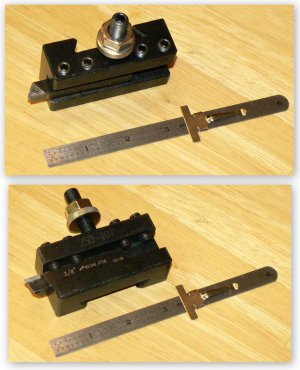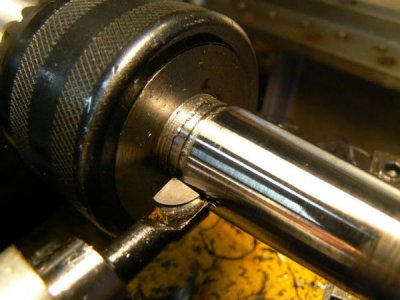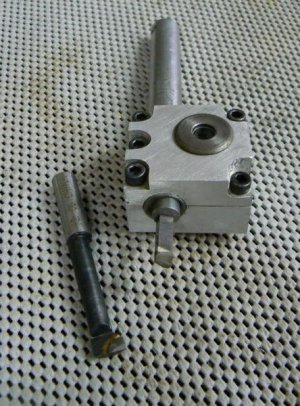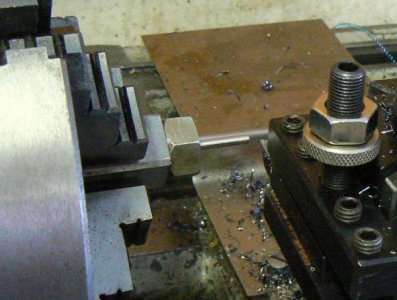This topic has been done to death but a few years ago, a sale advertised in the Enco catalog prompted a few experiments performed on HSS tooling and carbide inserts. The post is intended for HSM interest, focused on what works well in small lathes typically found in the home shop. Here are the materials that were evaluated and their cost:
(Note that the insert toolholders + cutters can be obtained at less cost from other distributors.)
Here are the five various tool holders; there is a RH and LH tool for facing to a shoulder, a RH and LH angled "roughing" tool (identical to the first two except that the cutting face is oriented at 30 degrees) and a "sort-of" threading tool (doesn't have enough side relief to cut coarse threads).
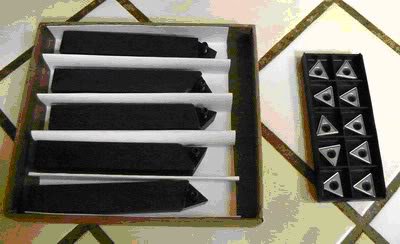
My first impression was that there may be no need for several of these toolholders, depending on the lathe toolpost. By rotating the toolpost slightly, the two right-angle turning tools ("right angle" in that they are normally positioned at ninety degrees to the turning axis) can perform the same operations that the two angled toolholders are intended to perform.
The "threading" toolholder can also be replaced by others in the set - the same insert is used for all holders (sixty degree included angle). The only reason for preferring any of the tools (other than RH or LH) is convenience, such as proximity/interference to/with chuck or tailstock.
Toolholders intended for "shouldering" may not be useful for the HSM unless the depth of cut is small. Most small lathes don't like to take a cut like this (cutting edge parallel to the shoulder) without complaint: excessive chattering and tool marks are typical. To make the shouldering operation without chatter, the spindle RPM must be slowed WAY down which sometimes defeats the purpose of the carbide tool for reducing turning time.
There's an alternative, however, for small lathes. One can turn at the desired speed/feed nearly up to the shoulder then switch off the motor, leaving the feed engaged (this is also the way that I approach some single-point threading chores with a small lathe).
After the spindle has wound down, the spindle/workpiece can be rotated by hand until the shoulder dimension is reached - at this point, disengage the feed and continue to rotate the spindle by hand until a clean, chatter-free face is obtained. Generally this takes only a turn or two.
A more conventional technique - probably the one that most of us use - is to turn the diameter to the shoulder with a cutter that is angled (so that the face is slightly concave) disregarding the chatter. Then withdraw the cutting tool (with the cross-slide), facing the shoulder to dimension with no chatter marks and perpendicular to the lathe axis.
I don't use a QC toolpost on my smaller lathe; they detract from rigidity on small lathes, IMO. The toolholders that I ordered needed to be modified to fit my 4-way so that the inserts are exactly on the spindle centerline (I don't use shims). I purchased a larger set intentionally so that I could custom fit them to my lathe.
To keep the cutting edge close to the edge of the four-way toolpost instead of hanging out excessively, I needed to remove 1.50 inches from the shank length. To position the cutting tool on the spindle centerline, about .060 needed to be removed from the bottom of the toolholders.
Neither of these modifications would present a problem if the toolholders were made from a (typical) semi-hard material, like 4140. But to my surprise (and delight) the toolholders were HARDENED - I had not expected this from a modestly-priced set. Normally, one would whack off the excess length with an abrasive cutoff wheel in a die grinder but my brother-in-law borrowed my compressor a month or so back for an auto restoration project (note to self: when compressor is returned, remove the wheels and throw them away to prevent future borrowing).
I installed an abrasive cut-off wheel in a trim router and cut down the shank of the holder. The toolholder was placed in the mill vise (upside-down, on parallels) and the thickness reduced to dimension in the vertical mill. (This operation could have been done three times more quickly and with better results in the horizontal mill but I didn't have carbide tooling for that machine at the time this was written.)
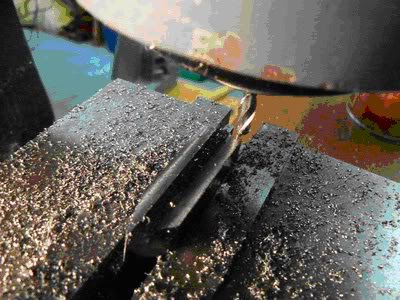
The mill spindle speed was 3200 RPM and a 1/4 solid carbide 4-flute end mill was installed in the collet. With toolholder firmly clamped in the mill vise, movement from all slides was minimized by tightening/snugging up the gib locks. Half of the excess material was removed with three longitudinal passes at about two inches/minute. A finer feed removed the remainder of the material (four passes at about one inch/minute).
Fine feed was necessary to avoid stressing the tip of the brittle end mill. As we know, a vertical mill is not a rigid machine so care must be exercised … even when backing the cutter out of a cut there could still be sufficient flexing to chip a cutting edge if rapid feed is employed. Here's the cut-down holder with insert installed in a four-way toolpost; note the support under the corner of the toolpost:
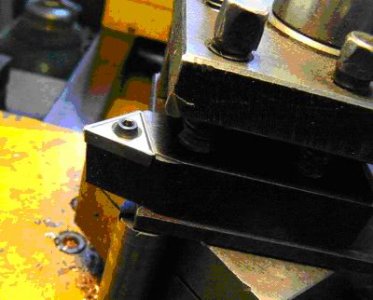
You may also want to review these posts:
http://www.hobby-machinist.com/threads/sharpening-cutting-tools.32987/
http://www.hobby-machinist.com/thre...ting-tools-on-small-lathes.32266/#post-273258
We know that there are at two major reasons for choosing carbide cutting tools over high-speed steel:
I'm not that familiar with modern carbide tooling but the rule of thumb that I've used for setting speeds is around 300 SFPM - compared to about 100 SFPM for HSS. This corresponds roughly to a spindle speed (in RPM) of 1200/diameter, where diameter is the workpiece diameter (for lathes) or the cutter diameter (for mills and all perimeter-cutting tools) in inches.
We might estimate the practicality of using carbide by considering the AVERAGE diameter workpiece (the one that accommodates 75% of our needs). In my case, that would probably be around 0.5 inch diameter. Using my rule of thumb, that translates to a spindle speed of 2400 RPM. My small lathe is old and the maximum spindle speed is around 2200 RPM. That is high enough so that carbide is obviously practical for improving productivity in my case.
To those of you routinely turning smaller workpieces, your lathe may not have high enough spindle RPM to make carbide a good choice - you'd have to be able to spin up to 4800 RPM to take full advantage of carbide tooling to turn 0.25 diameter workpieces, for example.
Here's a sanity estimate to determine the average steel workpiece diameter that can be efficiently used with carbide based on the maximum RPM of your lathe:
While carbide cutting tools are very hard they are not very sharp. Because of the brittleness of the material, it's pointless trying to achieve a razor edge (even if possible) that will chip at the first encounter with a workpiece.
This means that it's difficult to achieve close tolerances and fine finishes on slender workpieces because of deflection of the work (due to tool pressure) and the "whip" caused by increased spindle RPM. That may not have to be a problem, however, if one isn't timid about depth of cut.
A rigid small lathe can take a depth of cut (DOC) of 0.250 in mild steel with a sharp tool and fine feed. The inference: take the material off in a single pass, if possible, right? The trade-off is deflection (the workpiece ending up tapered). This may not be a problem for many applications - depending on the taper of course.
And that is what we are going to explore in this very brief evaluation. All experiments will be performed on my small "Compact Eight". This machine is very rigid because the ratio of the length of the ways to the width of the ways is small (about 5:1), it's fairly heavy and the 4-way toolpost is well-supported. The machine is probably more rigid than the average 12 inch Asian lathe with a QC toolpost. This is an old photo of the machine:
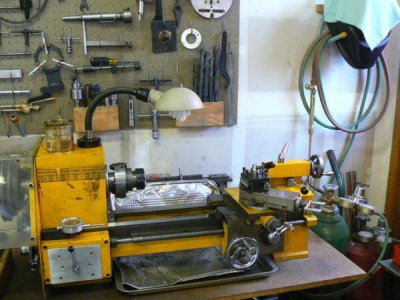
I bought the used lathe over thirty years ago and it seemed pricey at the time but it produces accurate parts in a reasonable length of time. The lathe routinely removes a cubic inch per minute of mild steel with a sharp HSS tool and we'll soon find out how it performs with carbide inserts.
Although the lathe appears to be mounted on a flimsy structure, the base was a stand for a 100 gallon aquarium (containing some 600 pounds of water). The stand was further reinforced by welding channel supports underneath the top and welding struts made from black pipe to all of the legs. (The 8 x 18 lathe weighs about 450 pounds.)
Simple tests that I devised for comparing the practical quality of the cutting edge don't include esoteric measurements of angles or examining cutting edges under a microscope - not even tool life. These aren't normally appropriate for garage machinists, LOL, like me.
I'm simply going to compare the insert with a reasonably sharp HSS cutter by taking a light cut (a hard thing to do with carbide tools when accuracy is required) using both types of tools on a length of 3/4 steel conduit with no end support. I did make one slight change to the HSS tool: I dressed a slight radius on the tip so that it would approximate the shape of the insert tip. Had I not done this, comparison of surface finish would not have been useful.
The expectation is that the material will flex away from the cutting edge since the unsupported conduit length will be set to three inches. I ran the HSS tool at 415 RPM and the carbide insert at 1330 RPM. These are conservative for the respective tool materials but I'm limited to the available pulley combinations on my smallest lathe. After making one pass at a DOC of about 0.035 and a feed rate of .005 ipr, the amount of taper from end-to-end was measured, as an indication of deflection (and therefore tool sharpness).
The 1/4 HSS tool deflected .00055 radial inches, surface finish estimated near 32 microinches
The 3/8 I.C. Carbide insert deflected .00155 radial inches, surface finish estimated between 32 and 63 microinches
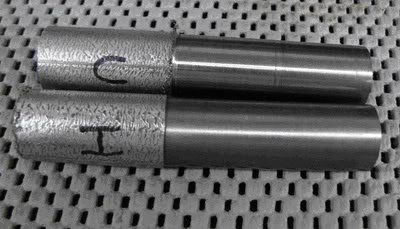
No surprises: the HSS produced less deflection and a finer finish, as was to be expected while the carbide insert removed the same amount of material about three times faster with three times greater deflection. Doubtless the finish of the carbide insert could have been improved by honing the tip with a diamond file but it might be at the expense of tool life.
(As a matter of interest, measurement of the diameters of the conduit was tricky because of the thin wall thickness remaining after turning. The small amount of force introduced by the micrometer thimble torque was adequate to slightly deflect the wall of the conduit, so a go/no-go method was used.)
The next test, also related to edge sharpness, will suggest the relative amount of power required to remove the same volume of material from identical bars with the different tools. Let's think about this for a moment … simple tests measure current consumption of the lathe motor, as an indication of the work performed.
I could certainly do that but the results mightn't be useful - the resistance of the motor winding will change as it heats therefore the current consumption will also change unless the motor was allowed to cool for a lengthy time period. My goal was to make the tests in thirty minutes and then spend thirty minutes writing up the results (I failed, by the way).
I decided to use methods similar to those of Newton and other early experimenters working with power and energy by measuring the amount of heat produced by the work of the cutting tool. I made infra-red temperature measurements on the workpieces, before and after removing a fixed amount of material with both types of cutting tools. The presumption is that temperature rise provides a good indication of the amount of work performed by each tool.
The test workpiece is 3/4 diameter CRS, the length of cut is 2 inches using the same spindle speeds noted above when turning the steel conduit. One pass of 0.100 DOC and .005 ipr was made for each tool and the difference in temperature noted immediately after the cut was performed. This was the first test, which had problems that will be described in a moment. Here's a photo of the 1/4 HSS tool preparing to turn the 3/4 rod:
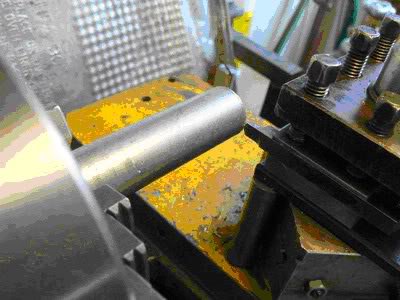
The temperature and deflection measurements of the first test weren't meaningful. The HSS tool cut smoothly without coolant while the carbide insert instantly generated a terrible chatter (remember that the workpiece is not supported at the end) and required coolant for the entire cut; no point in measuring temperature rise.
The chattering was again an indication of the lack of a keen edge on the carbide insert - the workpiece tended to deflect and set up the chatter that required application of coolant to "calm down". FWIW, stock removal was .42 cubic inches/minute for the HSS cutter and 1.36 cubic inches/minute for the carbide insert.
I centerdrilled the two test workpieces so that they could be supported from the tailstock and repeated the two tests except using .050 DOC without changing spindle RPM to suit the smaller diameters (recall that the test pieces have been reduced from .750 diameter to .550 diameter). No coolant was used on either piece and, with the work supported, no chattering was experienced.
The surface finish was similar in appearance to the surface finish reported on the two pieces of conduit turned earlier. That is, the HSS produced a slightly smoother finish than the carbide insert, both were acceptable for a 63 microinch finish requirement.
Temperature rise of the workpiece using a HSS tool was 16 degrees Celsius while the temperature of the workpiece turned with the carbide insert rose 32 degrees. One can make the (fairly reasonable) assumption that about twice the power was required to remove the same amount of material with the carbide insert.
For HSM applications, that may not be meaningful from an economic standpoint (electricity cost is usually of no concern). But it does suggest additional stresses imposed on your machine from having to work twice as hard to produce the same result. Again, this is no surprise, it has been common knowledge for decades.
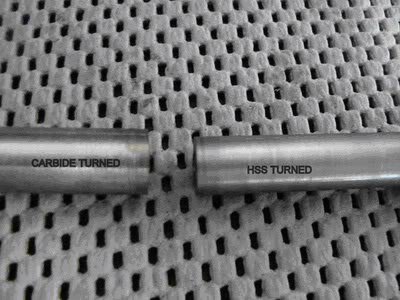
Comparing the carbide inserts to the 3/8 square brazed-carbide tooling that I normally use was interesting. The inserts seemed to be sharper (based on surface finish) although this may come at the cost of tool life. However, with three cutting surfaces on each insert, I'd expect the insert to last as long as a brazed carbide tool (making the assumption that neither was sharpened during their lifetimes). Initial tool costs between insert and brazed-carbide cutter are approximately equal.
Regarding quality of cut, cost and wear/tear on the lathe, HSS wins unless the workpiece is simply too hard to cut without using carbide or unless time is of consideration. Workpiece deflection using carbide is almost three times greater than with HSS while the turning speeds can be three times higher IF your lathe can accommodate the higher RPM. More often than not, this won't be the case for lathes over about ten inches swing so the performance advantage might be lost for small diameter work.
I see no reason to change my lifelong habit of roughing with carbide, if large amounts of metal need to be removed (cubic inches), and finish-turning with HSS. Facing might be a different story, though. I can definitely see using these inserts to face large workpieces when I don't want to be bothered with changing belts as the cutting diameter changes. My feeling is that these inserts produce not three times the productivity but something around 1-1/2 to twice the efficiency.
When less than one cubic inch of material needs to be removed, there's little reason to prefer carbide over HSS, given surface finish and finish-dimensioning advantages of the latter. As in every new job that comes along, it's wise to have a selection of tooling that can accommodate 95% of the materials and operations likely to be encountered. I couldn't work using only HSS. Likewise, I couldn't work using only carbide, whether inserts or brazed.
This is probably what my 4-way toolpost (in my smallest lathe) will look like for a while: 1/4 HSS in toolholder, 3/8 I.C. carbide insert in toolholder, 3/32 x 1/2 HSS parting tool in tool holder and one blank station for whatever comes along …
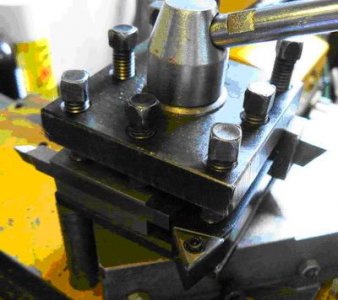
Please note that this test was VERY limited in scope, based on only one configuration and carbide material. I have no current knowledge of carbide tooling so there may well be better choices than the tool set and inserts that I purchased.
- 1/4 M2 HSS blank, hand-ground @ $1.10 each (Enco 383-5316 , mfr: Interstate) with shop-made toolholder in 4-way toolpost, the tool is always centered (no shims)
- 5/8 toolholders for inserts, 5 piece set $35.00 (Enco TG250-1402) with 3/8 I.C. carbide inserts, 10 @ $3.00 each (Enco TG340-1014, mfr: Interstate). Toolholders were modified so that the cutters are always centered (no shims).
(Note that the insert toolholders + cutters can be obtained at less cost from other distributors.)
Here are the five various tool holders; there is a RH and LH tool for facing to a shoulder, a RH and LH angled "roughing" tool (identical to the first two except that the cutting face is oriented at 30 degrees) and a "sort-of" threading tool (doesn't have enough side relief to cut coarse threads).

My first impression was that there may be no need for several of these toolholders, depending on the lathe toolpost. By rotating the toolpost slightly, the two right-angle turning tools ("right angle" in that they are normally positioned at ninety degrees to the turning axis) can perform the same operations that the two angled toolholders are intended to perform.
The "threading" toolholder can also be replaced by others in the set - the same insert is used for all holders (sixty degree included angle). The only reason for preferring any of the tools (other than RH or LH) is convenience, such as proximity/interference to/with chuck or tailstock.
Toolholders intended for "shouldering" may not be useful for the HSM unless the depth of cut is small. Most small lathes don't like to take a cut like this (cutting edge parallel to the shoulder) without complaint: excessive chattering and tool marks are typical. To make the shouldering operation without chatter, the spindle RPM must be slowed WAY down which sometimes defeats the purpose of the carbide tool for reducing turning time.
There's an alternative, however, for small lathes. One can turn at the desired speed/feed nearly up to the shoulder then switch off the motor, leaving the feed engaged (this is also the way that I approach some single-point threading chores with a small lathe).
After the spindle has wound down, the spindle/workpiece can be rotated by hand until the shoulder dimension is reached - at this point, disengage the feed and continue to rotate the spindle by hand until a clean, chatter-free face is obtained. Generally this takes only a turn or two.
A more conventional technique - probably the one that most of us use - is to turn the diameter to the shoulder with a cutter that is angled (so that the face is slightly concave) disregarding the chatter. Then withdraw the cutting tool (with the cross-slide), facing the shoulder to dimension with no chatter marks and perpendicular to the lathe axis.
I don't use a QC toolpost on my smaller lathe; they detract from rigidity on small lathes, IMO. The toolholders that I ordered needed to be modified to fit my 4-way so that the inserts are exactly on the spindle centerline (I don't use shims). I purchased a larger set intentionally so that I could custom fit them to my lathe.
To keep the cutting edge close to the edge of the four-way toolpost instead of hanging out excessively, I needed to remove 1.50 inches from the shank length. To position the cutting tool on the spindle centerline, about .060 needed to be removed from the bottom of the toolholders.
Neither of these modifications would present a problem if the toolholders were made from a (typical) semi-hard material, like 4140. But to my surprise (and delight) the toolholders were HARDENED - I had not expected this from a modestly-priced set. Normally, one would whack off the excess length with an abrasive cutoff wheel in a die grinder but my brother-in-law borrowed my compressor a month or so back for an auto restoration project (note to self: when compressor is returned, remove the wheels and throw them away to prevent future borrowing).
I installed an abrasive cut-off wheel in a trim router and cut down the shank of the holder. The toolholder was placed in the mill vise (upside-down, on parallels) and the thickness reduced to dimension in the vertical mill. (This operation could have been done three times more quickly and with better results in the horizontal mill but I didn't have carbide tooling for that machine at the time this was written.)

The mill spindle speed was 3200 RPM and a 1/4 solid carbide 4-flute end mill was installed in the collet. With toolholder firmly clamped in the mill vise, movement from all slides was minimized by tightening/snugging up the gib locks. Half of the excess material was removed with three longitudinal passes at about two inches/minute. A finer feed removed the remainder of the material (four passes at about one inch/minute).
Fine feed was necessary to avoid stressing the tip of the brittle end mill. As we know, a vertical mill is not a rigid machine so care must be exercised … even when backing the cutter out of a cut there could still be sufficient flexing to chip a cutting edge if rapid feed is employed. Here's the cut-down holder with insert installed in a four-way toolpost; note the support under the corner of the toolpost:

You may also want to review these posts:
http://www.hobby-machinist.com/threads/sharpening-cutting-tools.32987/
http://www.hobby-machinist.com/thre...ting-tools-on-small-lathes.32266/#post-273258
We know that there are at two major reasons for choosing carbide cutting tools over high-speed steel:
- Take advantage of higher spindle speeds (three times faster than HSS).
- Ability to turn material that is too hard for HSS tooling (as in the example above where the hardened shanks of the toolholders could only be sized with either a solid carbide cutter, a grinder or wire EDM).
I'm not that familiar with modern carbide tooling but the rule of thumb that I've used for setting speeds is around 300 SFPM - compared to about 100 SFPM for HSS. This corresponds roughly to a spindle speed (in RPM) of 1200/diameter, where diameter is the workpiece diameter (for lathes) or the cutter diameter (for mills and all perimeter-cutting tools) in inches.
We might estimate the practicality of using carbide by considering the AVERAGE diameter workpiece (the one that accommodates 75% of our needs). In my case, that would probably be around 0.5 inch diameter. Using my rule of thumb, that translates to a spindle speed of 2400 RPM. My small lathe is old and the maximum spindle speed is around 2200 RPM. That is high enough so that carbide is obviously practical for improving productivity in my case.
To those of you routinely turning smaller workpieces, your lathe may not have high enough spindle RPM to make carbide a good choice - you'd have to be able to spin up to 4800 RPM to take full advantage of carbide tooling to turn 0.25 diameter workpieces, for example.
Here's a sanity estimate to determine the average steel workpiece diameter that can be efficiently used with carbide based on the maximum RPM of your lathe:
- If your maximum spindle RPM is 1200 RPM, the smallest diameter that can efficiently utilize carbide is about one inch
- If your maximum spindle RPM is 2400 RPM, the smallest diameter that can efficiently utilize carbide is about 0.5 inch
- If your maximum spindle RPM is 3600 RPM, the smallest diameter that can efficiently utilize carbide is about 0.3 inch
While carbide cutting tools are very hard they are not very sharp. Because of the brittleness of the material, it's pointless trying to achieve a razor edge (even if possible) that will chip at the first encounter with a workpiece.
This means that it's difficult to achieve close tolerances and fine finishes on slender workpieces because of deflection of the work (due to tool pressure) and the "whip" caused by increased spindle RPM. That may not have to be a problem, however, if one isn't timid about depth of cut.
A rigid small lathe can take a depth of cut (DOC) of 0.250 in mild steel with a sharp tool and fine feed. The inference: take the material off in a single pass, if possible, right? The trade-off is deflection (the workpiece ending up tapered). This may not be a problem for many applications - depending on the taper of course.
And that is what we are going to explore in this very brief evaluation. All experiments will be performed on my small "Compact Eight". This machine is very rigid because the ratio of the length of the ways to the width of the ways is small (about 5:1), it's fairly heavy and the 4-way toolpost is well-supported. The machine is probably more rigid than the average 12 inch Asian lathe with a QC toolpost. This is an old photo of the machine:

I bought the used lathe over thirty years ago and it seemed pricey at the time but it produces accurate parts in a reasonable length of time. The lathe routinely removes a cubic inch per minute of mild steel with a sharp HSS tool and we'll soon find out how it performs with carbide inserts.
Although the lathe appears to be mounted on a flimsy structure, the base was a stand for a 100 gallon aquarium (containing some 600 pounds of water). The stand was further reinforced by welding channel supports underneath the top and welding struts made from black pipe to all of the legs. (The 8 x 18 lathe weighs about 450 pounds.)
Simple tests that I devised for comparing the practical quality of the cutting edge don't include esoteric measurements of angles or examining cutting edges under a microscope - not even tool life. These aren't normally appropriate for garage machinists, LOL, like me.
I'm simply going to compare the insert with a reasonably sharp HSS cutter by taking a light cut (a hard thing to do with carbide tools when accuracy is required) using both types of tools on a length of 3/4 steel conduit with no end support. I did make one slight change to the HSS tool: I dressed a slight radius on the tip so that it would approximate the shape of the insert tip. Had I not done this, comparison of surface finish would not have been useful.
The expectation is that the material will flex away from the cutting edge since the unsupported conduit length will be set to three inches. I ran the HSS tool at 415 RPM and the carbide insert at 1330 RPM. These are conservative for the respective tool materials but I'm limited to the available pulley combinations on my smallest lathe. After making one pass at a DOC of about 0.035 and a feed rate of .005 ipr, the amount of taper from end-to-end was measured, as an indication of deflection (and therefore tool sharpness).
The 1/4 HSS tool deflected .00055 radial inches, surface finish estimated near 32 microinches
The 3/8 I.C. Carbide insert deflected .00155 radial inches, surface finish estimated between 32 and 63 microinches

No surprises: the HSS produced less deflection and a finer finish, as was to be expected while the carbide insert removed the same amount of material about three times faster with three times greater deflection. Doubtless the finish of the carbide insert could have been improved by honing the tip with a diamond file but it might be at the expense of tool life.
(As a matter of interest, measurement of the diameters of the conduit was tricky because of the thin wall thickness remaining after turning. The small amount of force introduced by the micrometer thimble torque was adequate to slightly deflect the wall of the conduit, so a go/no-go method was used.)
The next test, also related to edge sharpness, will suggest the relative amount of power required to remove the same volume of material from identical bars with the different tools. Let's think about this for a moment … simple tests measure current consumption of the lathe motor, as an indication of the work performed.
I could certainly do that but the results mightn't be useful - the resistance of the motor winding will change as it heats therefore the current consumption will also change unless the motor was allowed to cool for a lengthy time period. My goal was to make the tests in thirty minutes and then spend thirty minutes writing up the results (I failed, by the way).
I decided to use methods similar to those of Newton and other early experimenters working with power and energy by measuring the amount of heat produced by the work of the cutting tool. I made infra-red temperature measurements on the workpieces, before and after removing a fixed amount of material with both types of cutting tools. The presumption is that temperature rise provides a good indication of the amount of work performed by each tool.
The test workpiece is 3/4 diameter CRS, the length of cut is 2 inches using the same spindle speeds noted above when turning the steel conduit. One pass of 0.100 DOC and .005 ipr was made for each tool and the difference in temperature noted immediately after the cut was performed. This was the first test, which had problems that will be described in a moment. Here's a photo of the 1/4 HSS tool preparing to turn the 3/4 rod:

The temperature and deflection measurements of the first test weren't meaningful. The HSS tool cut smoothly without coolant while the carbide insert instantly generated a terrible chatter (remember that the workpiece is not supported at the end) and required coolant for the entire cut; no point in measuring temperature rise.
The chattering was again an indication of the lack of a keen edge on the carbide insert - the workpiece tended to deflect and set up the chatter that required application of coolant to "calm down". FWIW, stock removal was .42 cubic inches/minute for the HSS cutter and 1.36 cubic inches/minute for the carbide insert.
I centerdrilled the two test workpieces so that they could be supported from the tailstock and repeated the two tests except using .050 DOC without changing spindle RPM to suit the smaller diameters (recall that the test pieces have been reduced from .750 diameter to .550 diameter). No coolant was used on either piece and, with the work supported, no chattering was experienced.
The surface finish was similar in appearance to the surface finish reported on the two pieces of conduit turned earlier. That is, the HSS produced a slightly smoother finish than the carbide insert, both were acceptable for a 63 microinch finish requirement.
Temperature rise of the workpiece using a HSS tool was 16 degrees Celsius while the temperature of the workpiece turned with the carbide insert rose 32 degrees. One can make the (fairly reasonable) assumption that about twice the power was required to remove the same amount of material with the carbide insert.
For HSM applications, that may not be meaningful from an economic standpoint (electricity cost is usually of no concern). But it does suggest additional stresses imposed on your machine from having to work twice as hard to produce the same result. Again, this is no surprise, it has been common knowledge for decades.

Comparing the carbide inserts to the 3/8 square brazed-carbide tooling that I normally use was interesting. The inserts seemed to be sharper (based on surface finish) although this may come at the cost of tool life. However, with three cutting surfaces on each insert, I'd expect the insert to last as long as a brazed carbide tool (making the assumption that neither was sharpened during their lifetimes). Initial tool costs between insert and brazed-carbide cutter are approximately equal.
Regarding quality of cut, cost and wear/tear on the lathe, HSS wins unless the workpiece is simply too hard to cut without using carbide or unless time is of consideration. Workpiece deflection using carbide is almost three times greater than with HSS while the turning speeds can be three times higher IF your lathe can accommodate the higher RPM. More often than not, this won't be the case for lathes over about ten inches swing so the performance advantage might be lost for small diameter work.
I see no reason to change my lifelong habit of roughing with carbide, if large amounts of metal need to be removed (cubic inches), and finish-turning with HSS. Facing might be a different story, though. I can definitely see using these inserts to face large workpieces when I don't want to be bothered with changing belts as the cutting diameter changes. My feeling is that these inserts produce not three times the productivity but something around 1-1/2 to twice the efficiency.
When less than one cubic inch of material needs to be removed, there's little reason to prefer carbide over HSS, given surface finish and finish-dimensioning advantages of the latter. As in every new job that comes along, it's wise to have a selection of tooling that can accommodate 95% of the materials and operations likely to be encountered. I couldn't work using only HSS. Likewise, I couldn't work using only carbide, whether inserts or brazed.
This is probably what my 4-way toolpost (in my smallest lathe) will look like for a while: 1/4 HSS in toolholder, 3/8 I.C. carbide insert in toolholder, 3/32 x 1/2 HSS parting tool in tool holder and one blank station for whatever comes along …

Please note that this test was VERY limited in scope, based on only one configuration and carbide material. I have no current knowledge of carbide tooling so there may well be better choices than the tool set and inserts that I purchased.


